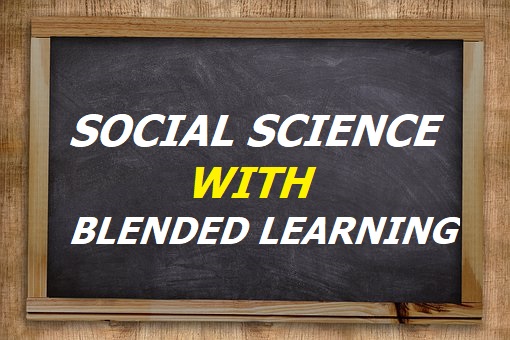Teaching And Learning Of Social Science With Blended Learning
Teaching And Learning Of Social Science With Blended Learning is the demand and requirement of the 21st century. Combining Digital With Traditional Classrooms With Blended Learning. This approach to learning offers numerous benefits, such as increased flexibility, individualized instruction, and access to a wider range of resources. Additionally, it has become even more relevant in today’s world, with the COVID-19 pandemic forcing many schools to transition to online learning. By combining digital and traditional classroom environments, blended learning has the potential to enhance the educational experience and prepare students for success in a rapidly changing world.
In this blog post, we will explore the advantages of blended learning, the different models of implementation, and best practices for ensuring its success. Whether you’re an educator, student, or parent, understanding how to effectively integrate technology with traditional teaching methods is becoming increasingly important. So, let’s dive in and discover the exciting possibilities of blended learning!
The Integration of Digital Technologies With Traditional Teaching Methods
Blended learning, the integration of digital technologies with traditional teaching methods, has become an increasingly popular approach in
education in recent years. As technology continues to evolve and transform the way we live, it’s no surprise that it’s changing the way we
learn too. With blended learning, students have the opportunity to learn in a variety of ways, whether it be through online lectures, virtual
discussions, or in-person classroom activities.
चार रोल प्ले गतिविधियां जो कक्षा में पढ़ाई को जोड़ें वास्तविक जीवन से
Teaching Social Science Through Blended Learning

Learning through technology
Social science is a diverse field that encompasses a wide range of disciplines, including sociology, psychology, anthropology, economics,
political science, and more. Blended learning in social science can take many forms, depending on the subject matter and the specific goals of
the course.
In a blended learning social science course, students may participate in online discussions, watch lectures or other multimedia content,
complete quizzes and assignments, and engage in collaborative learning activities. In-person sessions may be used for activities such as
group projects, discussions, and experiential learning opportunities, such as site visits, field trips, or role-playing exercises.
The advantages of blended learning in social science include increased flexibility, personalized learning, and greater access to resources and
information. It also allows for more interactive and engaging learning experiences that can promote greater understanding
and retention of course content.
Advantages Of Blended Learning In Social Science
Blended learning has become a popular approach in education due to the many advantages it offers.
In this blog post, we’ll explore the benefits of it specifically in the context of social science education.
Personalization of Learning
One of the biggest advantages of blended learning in social science is that it allows for a more personalized approach to learning.
Students can access online resources and materials that cater to their specific learning needs and preferences.
They can also work at their own pace.
Particularly beneficial for students who may struggle with traditional classroom teaching methods.
Increased Engagement
Blended learning in social science can also lead to increased engagement among students.
With a variety of resources and methods available, students are more likely to stay engaged and motivated throughout the learning process.
Online discussions and interactive activities can also encourage participation and collaboration among students.
Flexibility
This type of learning allows for greater flexibility in scheduling and location.
Students can access course materials and lectures online, which means they can work from anywhere and at any time.
This is particularly useful for students who have other commitments, such as work or family responsibilities.
Access to Resources
This type of learning provides students with access to a wide range of resources that may not be available in a traditional classroom setting.
For example,
students can access online databases, e-books, and multimedia resources that can enhance their understanding of social science concepts.
Improved Digital Literacy:
As technology continues to play an increasingly important role in our lives, it’s essential for students to develop strong digital literacy skills.
Blended learning can help students become more proficient in using technology and digital tools,
which can prepare them for success in the modern workforce.
Therefore, it offers many advantages in social science education.
By combining traditional teaching methods with digital technologies, students can benefit from increased personalization, engagement,
flexibility, access to resources, and improved digital literacy skills.
Limitations of blended learning in social science
Blended learning, which combines traditional face-to-face instruction with online learning, has become increasingly popular in recent years.
While there are many benefits to this approach, there are also some limitations, particularly when it comes to teaching social science.
In this blog post, we will explore some of the key limitations of blended learning in social science and how they can be addressed.
Lack of interaction
One of the biggest challenges of blended learning in social science is the lack of interaction between students and teachers.
Social science courses often require lively discussion and debate, which can be difficult to achieve online.
While online forums and chat rooms can help facilitate discussion, they are often not as effective as face-to-face interaction.
Limited access to resources
Another limitation of blended social science is limited access to resources.
Social science courses often require students to engage with primary sources, which may not be readily available online.
This can make it difficult for students to fully engage with the material and develop a deep understanding of the subject.
Technical difficulties
Technical difficulties can also pose a significant challenge.
Social science courses often require students to use specialized software and tools, which can be difficult to access or navigate online.
This can lead to frustration and a lack of engagement with the material.
Inconsistent learning experiences
Blended learning can also lead to inconsistent learning experiences.
Students may have different levels of access to technology, and some may struggle with the online components of the course.
This can create a divide between students who are able to engage fully with the material and those who are not.
Reduced motivation
Finally, blended learning can lead to reduced motivation among students.
Without the accountability and structure provided by traditional face-to-face instruction, students may be less motivated to engage with the
material and complete assignments.
Despite these limitations, there are ways to overcome them and make learning in social science more effective.
For example, teachers can use a variety of online tools to facilitate discussion and provide access to primary sources.
They can also provide technical support and ensure that all students have access to the necessary software and tools.
Finally, teachers can provide additional support and structure to help keep students motivated and engaged with the material.
Therefore, while blended learning in social science has its limitations, it can still be an effective way to teach students.
By recognizing these limitations and taking steps to address them, teachers can help ensure that students have a rich and engaging learning
experience, both online and in the classroom.
Blended Learning VS Traditional Classrooms

The debate over which teaching method is better, blended or traditional classrooms, has been ongoing for many years.
While both approaches have their advantages and disadvantages, there are some key differences between them that can help educators
decide which approach is best for their students.
In this blog post, we will explore the differences between blended learning and traditional classrooms.
Blended Learning
Blended learning combines face-to-face instruction with online learning.
This approach allows students to have more flexibility and control over their learning experience.
Students can access online resources, collaborate with their peers, and complete assignments at their own pace.
It also allows for personalized instruction, which can be tailored to meet the individual needs of each student.
Advantages
Flexibility
Blended learning allows students to learn at their own pace and on their own schedule.
They can access course materials, lectures, and assignments online, which makes it easier to balance school, work, and personal life.
Personalization
With blended learning, students can receive personalized instruction that meets their individual needs.
Teachers can provide additional support and resources to students who are struggling, while also challenging students who are excelling.
Collaboration
Blended learning encourages collaboration and teamwork among students.
Online discussions, group projects, and peer-to-peer feedback can help students learn from each other and build valuable communication
skills.
Disadvantages
Technical difficulties
Technical difficulties can be a major challenge in blended learning.
Students may have trouble accessing online resources or navigating the course platform, which can lead to frustration and a lack of
engagement.
Limited face-to-face interaction
Blended learning can limit face-to-face interaction between students and teachers.
This can be a disadvantage for students who thrive in a traditional classroom setting.
Traditional Classrooms
Traditional classrooms involve face-to-face instruction in a physical classroom.
This approach provides a structured and predictable learning environment that can be beneficial for students who prefer a more traditional
approach to learning.
Advantages
Face-to-face interaction
Traditional classrooms provide students with face-to-face interaction with teachers and peers.
This can be a valuable opportunity for students to ask questions, receive feedback, and engage in discussion and debate.
Structured environment
Traditional classrooms provide a structured environment that can help students stay focused and engaged with the material.
This can be particularly beneficial for students who struggle with self-motivation.
Access to resources
In a traditional classroom setting, students have immediate access to resources such as textbooks, handouts, and other materials that may
not be available online.
Disadvantages
Limited flexibility
Traditional classrooms may not be as flexible as blended learning.
Students may need to adjust their schedules to attend classes at specific times, which can be difficult for those with other obligations.
Limited personalization
In a traditional classroom, it can be challenging to provide personalized instruction that meets the individual needs of each student.
Limited collaboration
Traditional classrooms may not provide as many opportunities for collaboration and teamwork as blended learning.
This can be a disadvantage for students who thrive on working with others.
To sum up. both blended learning and traditional classrooms have their advantages and disadvantages.
When deciding which approach to use, educators should consider the needs and preferences of their students, as well as the resources and
technology available to them. By carefully weighing the pros and cons of each approach, educators can create a learning environment that is
both engaging and effective for their students.
Conclusion:
Blended learning, which combines digital and traditional classroom methods, offers several advantages such as flexibility, personalization, and collaboration. The use of technology can enhance learning experiences and provide access to resources that may not be available in a traditional classroom. However, it also comes with challenges such as technical difficulties and limited face-to-face interaction. Traditional classrooms, on the other hand, provide a structured environment and immediate access to resources but may lack flexibility and personalization. By carefully considering the needs of their students and utilizing the advantages of both approaches, educators can create a dynamic learning environment that maximizes the benefits of both digital and traditional teaching methods.
What was it like for you to read or teach online during the lockdown? Did you like taking classes online? Do you believe that instructors should switch from traditional to blended learning methods of instruction? Please share your experiences.





0 Comments